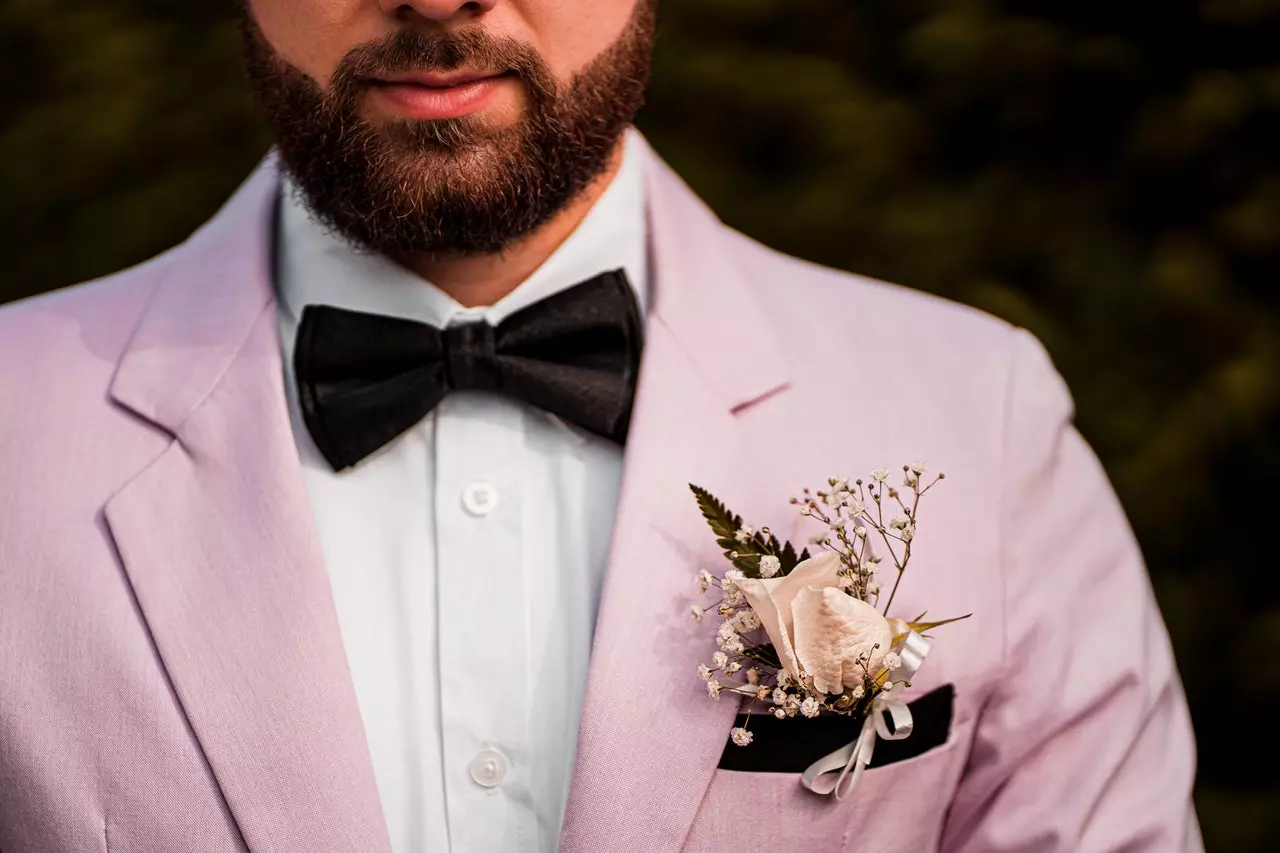Although boutonnieres aren’t exactly rare, they’re not the most common, with many people wearing a flower on their jacket lapel just a few times in their life, like prom or cosplaying as a turn-of-the-century member of the gentry. Which is a shame: nothing adds more style and panache than a well-placed, thoughtfully picked out boutonniere to really round out an outfit.
As a 21st century dad, it’s time you set an example with your kids and re-introduce them to the concept of boutonniere’s, when to wear them, how to wear them, and why it should be integral to any good suit jacket.
Boutonniere Basics: Occasions for the Boutonniere
In general, boutonnieres are worn during formal events such as, but not limited to:
- Proms
- Anniversaries
- Opening night at a theater or opera
- Weddings
- Anniversaries
- Quinceñera
But here’s the thing: a boutonniere is pretty much appropriate for any event wherein you need to stand out. However, somber events like funerals or job interviews aren’t great events for a person to wear a boutonniere.
Boutonniere Basics: Wearing the Boutonniere

Traditionally, boutonnieres are worn on the left lapel of a suit, sport jacket, or a blazer, although boutonnieres on an overcoat aren’t uncommon either.
Boutonnieres are always attached on the left because it’s supposed to rest right above the wearer’s heart. In general, boutonnieres are attached to the lapel’s buttonhole. The buttonhole is usually an inch to an inch-and-a-half opening on the lapel. Originally, these were added during the 19th century and served as a way for the wearer to close up the lapel and protect their neck from the elements. Now, however, it’s a handy way to add pins and, you guessed it, boutonnieres.
However, you’ll need a high-quality suit to have a lapel buttonhole that is functional (that is, it comes with a latch) and strong enough to support boutonnieres of varying weights and complexity. Some suits, however, come with a specialized boutonniere latch located on the inside of the lapel next to the buttonhole. This is a good indication that the suit you bought is of great quality, mostly because the tailor added that little flair specifically because they know the value a boutonniere adds to the overall aesthetic of a suit jacket.
Buttonholes and boutonniere latches, however, need to be specially made to accommodate your flowers: it’ll need a very strong inner lining, with the buttonhole itself being both hand-cut and stitched. Silk latches should also be sewn an inch or two underneath the actual buttonhole to protect it from damage. In general, you can only find this type of quality in bespoke pieces, as mass-produced, ready-to-wear, off-the-rack suits will simply not have this convenience factored into their production.
But what if your budget calls for a ready-to-wear piece that doesn’t have a lapel buttonhole? Not to worry, you can still wear a boutonniere and have people none the wiser. The easiest option, of course, is to simply pin the boutonniere on your lapel. However, this runs the risk of the actual pin needle damaging your lapel should your boutonniere catch on something. Your other option is to have a buttonhole cut out from the lapel. The latter is the best-case solution if you actually own the jacket; this is obviously not an option if you’re renting your suit, thus confining you to a pinned boutonniere instead.
Should you opt for the second option, though, make sure to tell your tailor or seamstress to hand-cut and double-stitch the buttonhole. This ensures that the buttonhole itself will be able to support the boutonnieres full weight without any sagging or tearing
Boutonniere Basics: Why Wear a Boutonniere in the First Place?
And now we come to the crux of the matter: why wear a boutonniere in the first place? Why does it matter? Well, the simplest reason is you do what you want, dang it, here are a few more reasons as to why people should consider wearing boutonnieres on their lapels:
It Breaks the Monotony
A boutonniere is interesting, to say the least: because boutonnieres have gradually faded away from mainstream fashion, anyone wearing a flower on their lapel instantly helps you stand out from the crowd. Think about it: have you ever seen photos of celebrities on the red carpet? All the women look stunning in beautiful, colorful dresses, with no two being alike. Meanwhile, all the people wearing suits and suit jackets all look practically the same. Yes, they still look dashing, but at the same time, uniform.
A boutonniere breaks that monotony and gets the conversation going. Personally, boutonnieres also indicate a couple of other things as well.
It Shows Your Attention to Detail
The essence of what it means to be ‘well-dressed’ isn’t about following the latest fashion trend: rather, it’s about paying attention to the details of your outfit, from the overall theme and aesthetic to the tiniest buttonholes and, yes, boutonnieres.
The best boutonnieres are small enough to be subtle, but colorful enough to make a statement. A boutonniere shows people that you pay attention to the little things that make life a little more enjoyable, a little more beautiful, and honestly, a little more interesting!
These are great lessons to teach your children about being confident about what they wear and using fashion as a way for them to express themselves without being garish or obnoxious. As a 21st century Dad, it’s high time we started bringing back the boutonniere and start dressing up well again!

